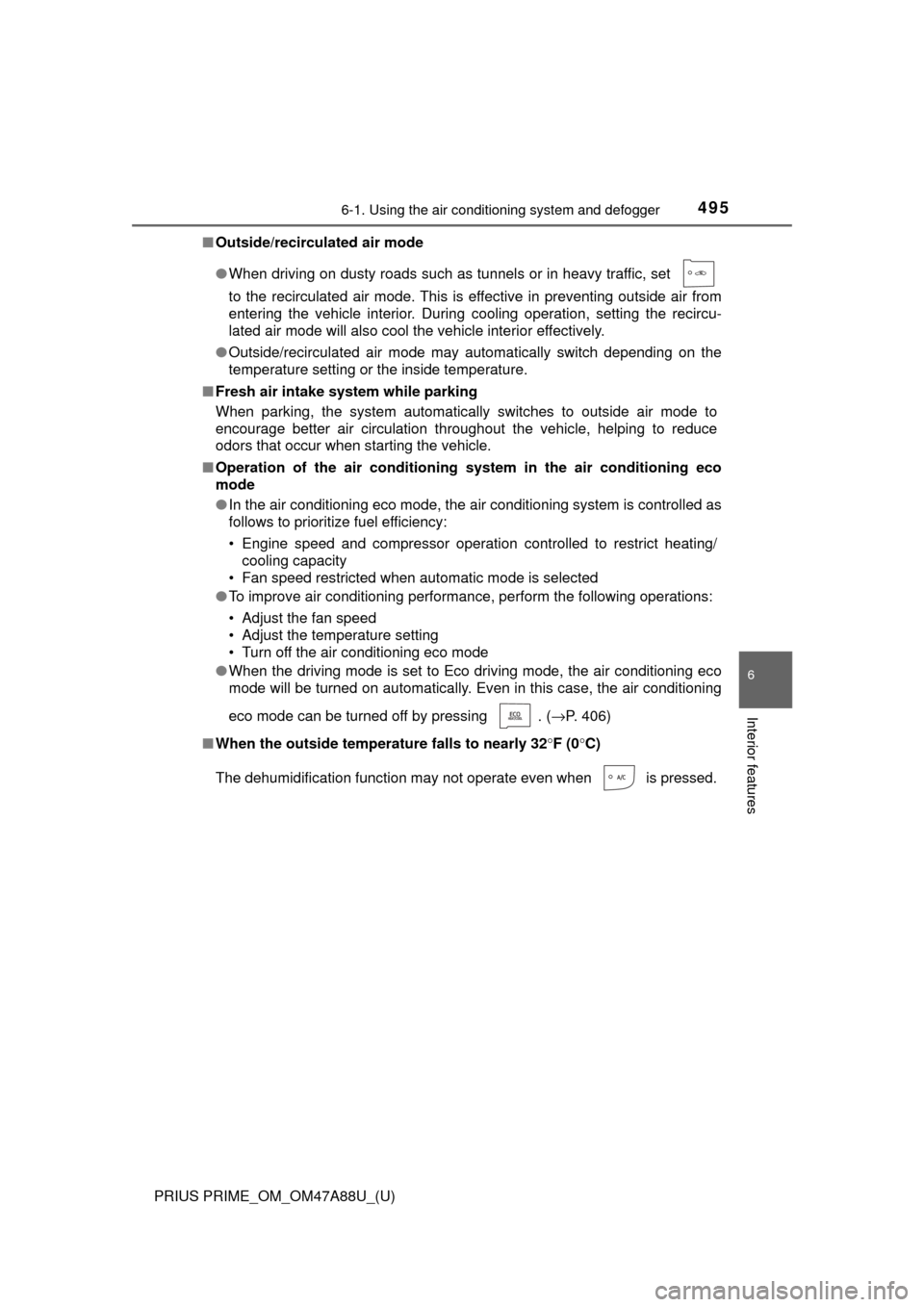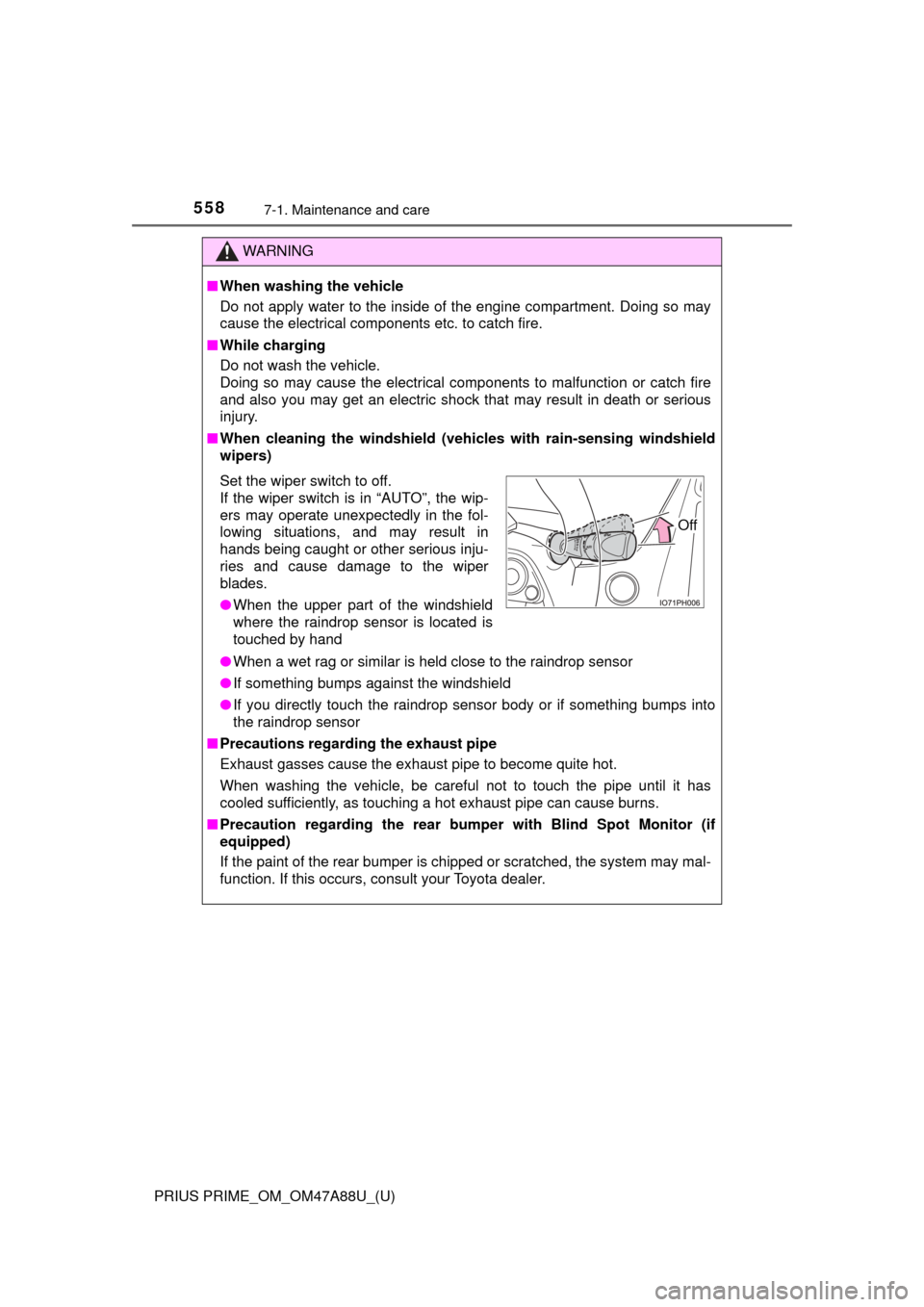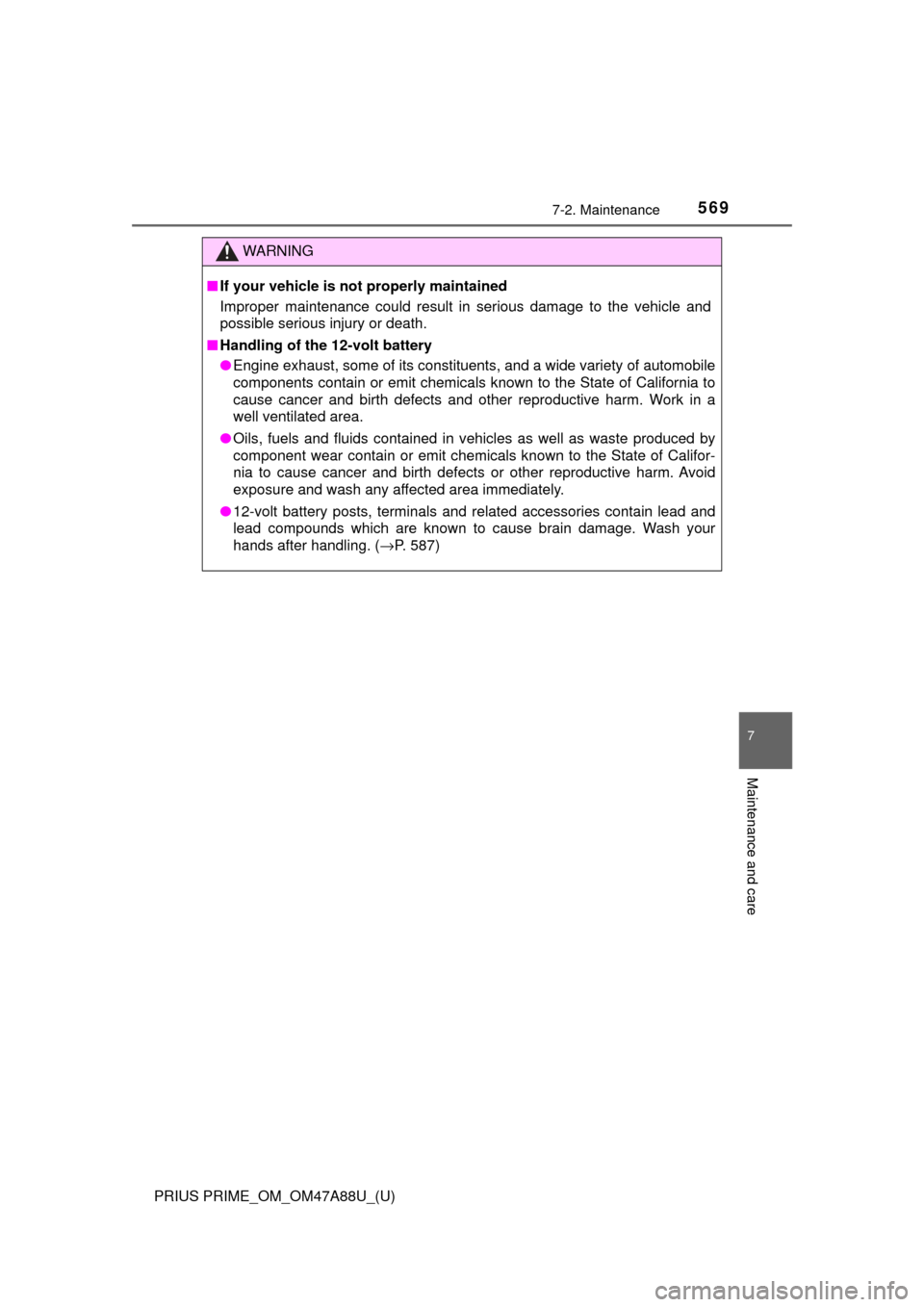2017 TOYOTA PRIUS PRIME engine
[x] Cancel search: enginePage 484 of 784

484
PRIUS PRIME_OM_OM47A88U_(U)
5-6. Driving tips
■Tire chain installation
Observe the following precautions when installing and removing chains:
●Install and remove tire chains in a safe location.
● Install tire chains on the front tires only. Do not install tire chains on the rear
tires.
● Install tire chains on front tires as tightly as possible. Retighten chains after
driving 1/4 - 1/2 mile (0.5 - 1.0 km).
● Install tire chains following the instructions provided with the tire ch\
ains.
■ Consumption of fuel and electricity
In cold temperatures, resistance of the parts of a vehicle (transmission, tires,
etc.) generally increases, resulting in increase of energy consumption. As a
result, fuel economy is likely to decrease.
Consumption of fuel and electricity of this vehicle is also likely to become
worse in cold temperatures.
WARNING
■Driving with snow tires
Observe the following precautions to reduce the risk of accidents.
Failure to do so may result in a loss of vehicle control and cause death or
serious injury.
● Use tires of the specified size.
● Maintain the recommended level of air pressure.
● Do not drive in excess of 75 mph (120 km/h), regardless of the type of
snow tires being used.
● Use snow tires on all, not just some wheels.
■ Driving with tire chains
Observe the following precautions to reduce the risk of accidents.
Failure to do so may result in the vehicle being unable to be driven safely,
and may cause death or serious injury.
● Do not drive in excess of the speed limit specified for the tire chains being
used, or 30 mph (50 km/h), whichever is lower.
● Avoid driving on bumpy road surfaces or over potholes.
● Avoid sudden acceleration, abrupt steering, sudden braking and shifting
operations that cause sudden engine braking.
● Slow down sufficiently before entering a curve to ensure that vehicle con-
trol is maintained.
■ When parking the vehicle
When parking the vehicle without applying the parking brake, make sure to
chock the wheels. If you do not chock the wheels, the vehicle may move
unexpectedly, possibly resulting in an accident.
Page 493 of 784

PRIUS PRIME_OM_OM47A88U_(U)
4936-1. Using the air conditioning system and defogger
6
Interior features
■Heating
●In HV mode, the gasoline engine may operate in order to exhaust heat from
the engine coolant via the heater.
● In EV mode, heating is done by a heat pump system.
• When the outside temperature is low or it is snowing, compared to con-
ventional vehicles, heating may be less effective and warm air may not
come out.
• If frost has formed on the outside heat exchanger, the heating perfor- mance will decline. The frost can be removed from the outside heat
exchanger by operating the Remote Air Conditioning System before driv-
ing ( →P. 509). When frosted over, the heating operation of the Remote
Air Conditioning System starts after defrosting.
• When is turned on, the heating is controlled optimally. Therefore, the set heating performance may not be achieved even if the fan speed
setting is increased.
● In the following situations the gasoline engine may operate in order to
exhaust heat from the engine coolant via the heater even in EV mode.
• The outside temperature is approximately -10 °C or low
• is operating
■ Using automatic mode
Fan speed is adjusted automatically according to the temperature setting and
the ambient conditions.
Therefore, the fan may stop for a while until warm or cool air is ready to flow
immediately after is pressed.
■ Water droplets during air conditioning operation• When the outside heat exchanger is
frosted over, fan speed declines and it
may become harder to heat the inte-
rior. However, it is not a malfunction.
In this situation, the air temperature
from the outlets may not change even
though the set temperature is raised.
The outside heat exchanger, accumulator
and air conditioning piping may incur con-
densation or frost may form. During or
after the air conditioning operation, water
droplets may fall from the vehicle. How-
ever, it is not a malfunction.
Outside heat exchanger
Outside heat exchanger
Accumulator
Page 495 of 784

PRIUS PRIME_OM_OM47A88U_(U)
4956-1. Using the air conditioning system and defogger
6
Interior features
■Outside/recirculated air mode
●When driving on dusty roads such as tunnels or in heavy traffic, set
to the recirculated air mode. This is effective in preventing outside air from
entering the vehicle interior. During cooling operation, setting the recircu-
lated air mode will also cool the vehicle interior effectively.
● Outside/recirculated air mode may automatically switch depending on the
temperature setting or the inside temperature.
■ Fresh air intake system while parking
When parking, the system automatically switches to outside air mode to
encourage better air circulation throughout the vehicle, helping to reduce
odors that occur when starting the vehicle.
■ Operation of the air conditioning system in the air conditioning eco
mode
●In the air conditioning eco mode, the air conditioning system is controlled as
follows to prioritize fuel efficiency:
• Engine speed and compressor operation controlled to restrict heating/
cooling capacity
• Fan speed restricted when automatic mode is selected
● To improve air conditioning performance, perform the following operations:
• Adjust the fan speed
• Adjust the temperature setting
• Turn off the air conditioning eco mode
● When the driving mode is set to Eco driving mode, the air conditioning eco
mode will be turned on automatically. Even in this case, the air conditioning
eco mode can be turned off by pressing . ( →P. 406)
■ When the outside temperat ure falls to nearly 32°F (0°C)
The dehumidification function may not operate even when is pressed.
Page 504 of 784

5046-1. Using the air conditioning system and defogger
PRIUS PRIME_OM_OM47A88U_(U)
■Heating
●In HV mode, the gasoline engine may operate in order to exhaust heat from
the engine coolant via the heater.
● In EV mode, heating is done by a heat pump system.
• When the outside temperature is low or it is snowing, compared to con-
ventional vehicles, heating may be less effective and warm air may not
come out.
• If frost has formed of the outside heat exchanger, the heating perfor- mance will decline. The frost can be removed from the outside heat
exchanger by operating the Remote Air Conditioning System before driv-
ing ( →P. 509). When frosted over, the heating operation of the Remote
Air Conditioning System starts after defrosting.
• When is turned on, the heating is controlled optimally. There- fore, the set heating performance may not be achieved even if the fan
speed setting is increased.
● In the following situations the gasoline engine may operate in order to
exhaust heat from the engine coolant via the heater even in EV mode.
• The outside temperature is extremely low
• is operating
■ Using automatic mode
Fan speed is adjusted automatically according to the temperature setting and
the ambient conditions.
Therefore, the fan may stop for a while until warm or cool air is ready to flow
immediately after is pressed.
■ Water droplets during air conditioning operation• When the outside heat exchanger is
frosted over, fan speed declines and it
may become harder to heat the inte-
rior. However, it is not a malfunction.
In this situation, the air temperature
from the outlets may not change even
though the set temperature is raised.
The outside heat exchanger, accumulator
and air conditioning piping may incur con-
densation or frost may form. During or
after the air conditioning operation, water
droplets may fall from the vehicle. How-
ever, it is not a malfunction.
Outside heat exchanger
Outside heat exchanger
Accumulator
Page 506 of 784

5066-1. Using the air conditioning system and defogger
PRIUS PRIME_OM_OM47A88U_(U)■
Fresh air intake system while parking
When parking, the system automatically switches to outside air mode to
encourage better air circulation throughout the vehicle, helping to reduce
odors that occur when starting the vehicle.
■ Operation of the air conditioning system in the air conditioning eco
mode
●In the air conditioning eco mode, the air conditioning system is controlled as
follows to prioritize fuel efficiency:
• Engine speed and compressor operation controlled to restrict heating/
cooling capacity
• Fan speed restricted when automatic mode is selected
● To improve air conditioning performance, perform the following operations:
• Adjust the fan speed
• Adjust the temperature setting
• Turn off the air conditioning eco mode
● When the driving mode is set to Eco driving mode, the air conditioning eco
mode will be turned on automatically. Even in this case, the air conditioning
eco mode can be turned off by selecting . ( →P. 406)
■ When the outside temperat ure falls to nearly 32°F (0°C)
The dehumidification function may not operate even when is
selected.
■ Ventilation and air conditioning odors
●To let the fresh air in, set the air conditioning system to the outside air mode.
● During use, various odors from inside and outside the vehicle may enter into
and accumulate in the air conditioning system. This may then cause odor to
be emitted from the vents.
● In order to suppress odors that occur when the air conditioning system
starts, fresh air is automatically taken in when parked.
● To reduce potential odors from occurring, the start timing of the blower may
be delayed for a short period of time i mmediately after the air conditioning
system is started in automatic mode.
■ Air conditioning filter
→P. 620
■ Customization
Settings (e.g. A/C auto switching operation) can be changed. (Customizable
features: →P. 732)
Page 555 of 784

555
PRIUS PRIME_OM_OM47A88U_(U)
7Maintenance and care
7-1. Maintenance and careCleaning and protecting the vehicle exterior .......... 556
Cleaning and protecting the vehicle interior ........... 561
7-2. Maintenance Maintenance requirements ................... 567
General maintenance........ 570
Emission inspection and maintenance (I/M)
programs......................... 573
7-3. Do-it-yourself maintenance Do-it-yourself service precautions ..................... 574
Hood ................................. 577
Positioning a floor jack ...... 579
Engine compartment ......... 580
Tires .................................. 594
Tire inflation pressure ....... 603
Wheels .............................. 606
Replacing the tire .............. 609
Air conditioning filter.......... 620
Wiper rubber replacement .................... 624
Electronic key battery........ 627
Checking and replacing fuses ............................... 630
Headlight aim .................... 633
Light bulbs......................... 635
Page 558 of 784

558
PRIUS PRIME_OM_OM47A88U_(U)
7-1. Maintenance and care
WARNING
■When washing the vehicle
Do not apply water to the inside of the engine compartment. Doing so may
cause the electrical components etc. to catch fire.
■ While charging
Do not wash the vehicle.
Doing so may cause the electrical components to malfunction or catch fire
and also you may get an electric shock that may result in death or serious
injury.
■ When cleaning the windshield (veh icles with rain-sensing windshield
wipers)
● When a wet rag or similar is held close to the raindrop sensor
● If something bumps against the windshield
● If you directly touch the raindrop sensor body or if something bumps into
the raindrop sensor
■ Precautions regarding the exhaust pipe
Exhaust gasses cause the exhaust pipe to become quite hot.
When washing the vehicle, be careful not to touch the pipe until it has
cooled sufficiently, as touching a hot exhaust pipe can cause burns.
■ Precaution regarding the rear bumper with Blind Spot Monitor (if
equipped)
If the paint of the rear bumper is chipped or scratched, the system may mal-
function. If this occurs, consult your Toyota dealer.
Set the wiper switch to off.
If the wiper switch is in “AUTO”, the wip-
ers may operate unexpectedly in the fol-
lowing situations, and may result in
hands being caught or other serious inju-
ries and cause damage to the wiper
blades.
● When the upper part of the windshield
where the raindrop sensor is located is
touched by hand
Off
Page 569 of 784

PRIUS PRIME_OM_OM47A88U_(U)
5697-2. Maintenance
7
Maintenance and care
WARNING
■If your vehicle is not properly maintained
Improper maintenance could result in serious damage to the vehicle and
possible serious injury or death.
■ Handling of the 12-volt battery
● Engine exhaust, some of its constituents, and a wide variety of automobile
components contain or emit chemicals known to the State of California to
cause cancer and birth defects and other reproductive harm. Work in a
well ventilated area.
● Oils, fuels and fluids contained in vehicles as well as waste produced by
component wear contain or emit chemic als known to the State of Califor-
nia to cause cancer and birth defects or other reproductive harm. Avoid
exposure and wash any affected area immediately.
● 12-volt battery posts, terminals and related accessories contain lead and
lead compounds which are known to cause brain damage. Wash your
hands after handling. ( →P. 587)